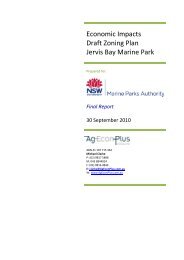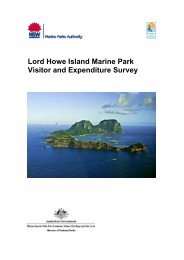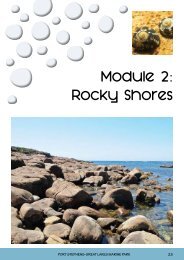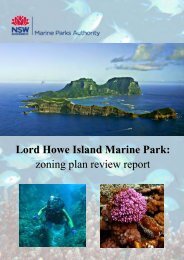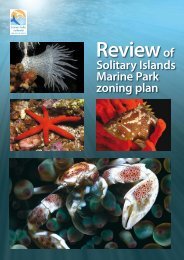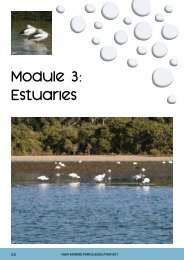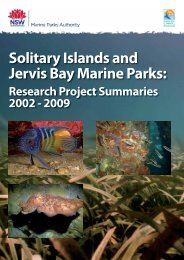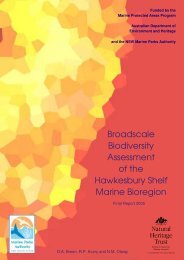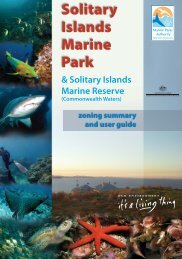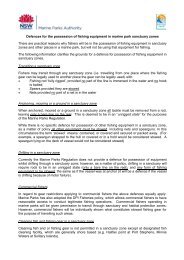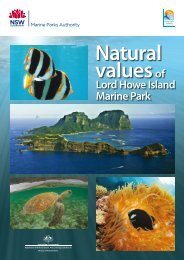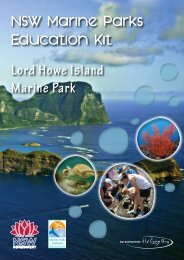Natural values of the Solitary Islands Marine Park - Marine Parks ...
Natural values of the Solitary Islands Marine Park - Marine Parks ...
Natural values of the Solitary Islands Marine Park - Marine Parks ...
- No tags were found...
Create successful ePaper yourself
Turn your PDF publications into a flip-book with our unique Google optimized e-Paper software.
8 <strong>Natural</strong> <strong>values</strong> <strong>of</strong> <strong>the</strong> <strong>Solitary</strong> <strong>Islands</strong> <strong>Marine</strong> <strong>Park</strong>Figure 9.Resistant layers <strong>of</strong> rockstrata in a fossilisedsequence <strong>of</strong> induratedsandstone.Figure 10.A swim-through and gutterformation on a shallowrocky reef.Throughout <strong>the</strong> C<strong>of</strong>fs Harbour area, hard metamorphosed slates jut out over much<strong>of</strong> <strong>the</strong> seabed from Sawtell to Brooms Head. These slates form numerous submergedreefs, washes and emergent islands, islets and rocks, including <strong>the</strong> five main islands in<strong>the</strong> <strong>Solitary</strong> <strong>Islands</strong> group and at least 10 smaller islets and rocks (e.g. North-west Rock).These outcrops are a seaward extension <strong>of</strong> <strong>the</strong> adjacent coastal range, which has astrong influence on <strong>the</strong> coastline <strong>of</strong> <strong>the</strong> marine park.Variations in sea level have also influenced <strong>the</strong> geomorphology <strong>of</strong> <strong>the</strong> marine park,with <strong>the</strong> sea level being considerably lower during <strong>the</strong> last glacial period around20,000–15,000 years ago. Different erosionaland depositional forces acted on <strong>the</strong> rocks andsediments <strong>of</strong> this area during that time. A linear reef,paralleling <strong>the</strong> coastline in places, occurs at a depth<strong>of</strong> about 60 metres, and this may be a previouscoastline (paleocoastline).The coastal streams and rivers immediately adjacentto <strong>the</strong> marine park are very short due to <strong>the</strong>proximity <strong>of</strong> <strong>the</strong> coastal range, and this shortnessinfluences sediment rates and inputs.Shelf sediments in <strong>the</strong> area consist mainly <strong>of</strong>material from rivers and streams, relic quartzose(i.e. material resembling or containing quartz) andcarbonate rich sands (Zann 2000a). The structure<strong>of</strong> <strong>the</strong> ocean beaches is strongly influenced bywave exposure, resulting in sand bars, troughsand gutters, and rip channels that are frequentlychanging (Short 2003) (Figure 12). While <strong>the</strong> seabedmorphological zones can be defined by differencesin slope, relief and distance from <strong>the</strong> shore, apartfrom <strong>the</strong> bedrock areas <strong>the</strong>y are dominated by sand.The wide distribution <strong>of</strong> sand throughout <strong>the</strong> innercontinental shelf reflects <strong>the</strong> absence <strong>of</strong> coastalsediments finer than sand; high-energy, strong tidalcurrents; and oceanic swells (Boyd et al 2004).



